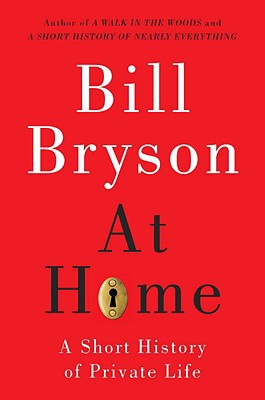At Home: A Short History of Private Life
Doubleday, October 5, 2010.
Hardcover, 512 pages.
ISBN: 0767919394

For readers who enjoy finding new ways of looking at history, Bill Bryson's newest book is going to fascinate and entertain. Inspired by a Victorian parsonage in the county of Norfolk which he and his family rented, Bryson began to pose the question of how mankind came to live in the modern homes we use today.
At Home: A Short History of Private Life is going to turn upside down every idea preached in social studies classes, and the reader will find new questions arising about how we came to live as we do in the twenty-first century. Where and how we live reflects who we are or who we would like to be. Most of us think we know the answer, but be prepared to look at everything in a new and very entertaining way. Bill Bryson has plumbed all the findings and theories of scholars and archeologists and presented them in an easy, affable style. Incorporated into the history of how we lived is the history of associated words, which is always interesting to those who enjoy reading.
In chapters named for the parts of a house, Bryson comes up with surprising new facts about how things came to be as they are now. The reader will find that instead of moving into the well-designed villas that the Romans left after their departure, the English locals had a different idea. They actually moved their own type of inferior housing right next door to luxurious homes equipped with heating, plumbing and other comforts.
In Medieval times, when much time was devoted to travel, old chests were given a domed top so that water would run off easily. It took until the 1600's for someone to come up with the greater efficiency of putting drawers into a chest, so that personal articles could be arranged better. The chest morphed into a chest of drawers.
The chapter on the kitchen will cause the reader to wonder how anyone survived at all given the condition of food, lack of refrigeration, and the horrifying ingredients that were added to food due to ignorance, carelessness, or just plain dishonesty. The addition of ice to the consumption of food is an amazing and surprising tale that takes the author on a hilarious recount of what happened to the first shipment of ice to Britain from New England. It seems that customs officials were so puzzled about how to classify it that the entire shipment (3 tons) melted before they could reach a reasonable conclusion.
At Home provides entertainment in every paragraph, and it is exactly the kind of book that one would like to take on journeys both short or long. It is not a small, lightweight book: it contains an extensive investigation of every room in a house with all related subjects, as well as a thorough bibliography for pursuing interesting related facts. The only solution is to obtain at least one copy on your favorite e-reader, because At Home is like having the companionship of an amusing and very erudite friend along to avoid boredom and insert diversion into the tedious delays in modern life that can deaden our spirits and fray our nerves.
--Sarah Reaves White
At Home: A Short History of Private Life is available for purchase on Amazon.com
Note: We may receive a commission from sales made through product links in this article.
